If you hope to blur the lines between indoor and outdoor living, think about putting a pergola in your yard. This architectural element, similar to an arbor, is typically supported by concrete footings and posts. It can be freestanding or attached to your home, offering a versatile addition to your outdoor space.
Unlike a gazebo with its solid roof, a pergola features an airy, open ceiling of beams and rafters, filtering light while providing some shelter and shade. Available in various materials, sizes, and styles, pergolas are a perfect way to define and enhance your outdoor living area, creating a serene retreat or a lively social space.
Ways To Add a Pergola to Your Backyard
A pergola’s primary purpose is to visually delineate an area for specific activities such as lounging, dining, or grilling, while also tying your house and landscape together. It can be placed on a deck, patio, or directly on the lawn. If you’re building or renovating a home, consult with an architect or designer about incorporating a pergola. Additionally, numerous pergola kits are available, and there are even free plans online for ambitious DIY enthusiasts.
Let’s explore some inspiring ideas to help you find the perfect pergola for your space and enhance your backyard’s functionality and aesthetic appeal.
Consider Cedar
Cedar remains one of the most popular wood choices for backyard structures, and for good reason. It’s durable, naturally resistant to decay, and widely available, making it a budget-friendly option. A cedar pergola with decorative arches and scroll cuts complements most traditional homes beautifully. This type of pergola can seamlessly blend into existing garden landscapes, creating a cohesive and charming environment. If you’re looking for an alternative to cedar, consider redwood. While it’s more expensive, it offers even greater durability and a rich, natural look that can elevate the overall appearance of your outdoor space.
Other Woods Ideas for a Pergola
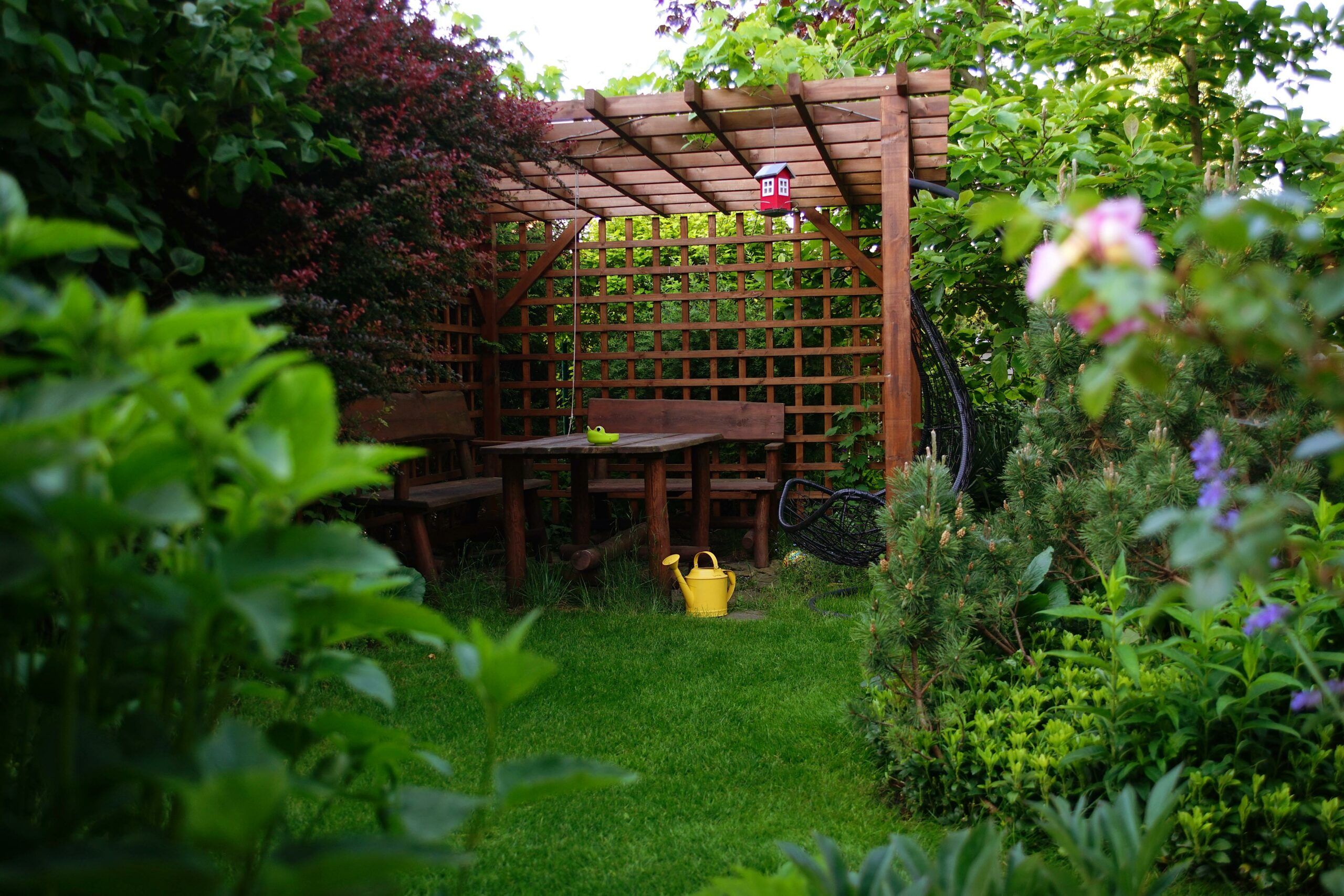
Pine is another relatively inexpensive option for pergolas. If you’re willing to stain it yourself, you can save even more. While pine is more susceptible to warping and weather damage than cedar or redwood, pressure-treated pine offers improved durability that can withstand harsher conditions. Other wood options include teak, fir, and acacia. For a truly unique pergola, consider incorporating reclaimed barn wood, salvaged beams, or even a backyard tree into your design. This not only adds a rustic charm but also promotes sustainability by reusing materials. Each wood type offers its own aesthetic appeal and level of durability, so consider your climate and maintenance preferences when making your choice.
Make a Modern Pergola With Metal
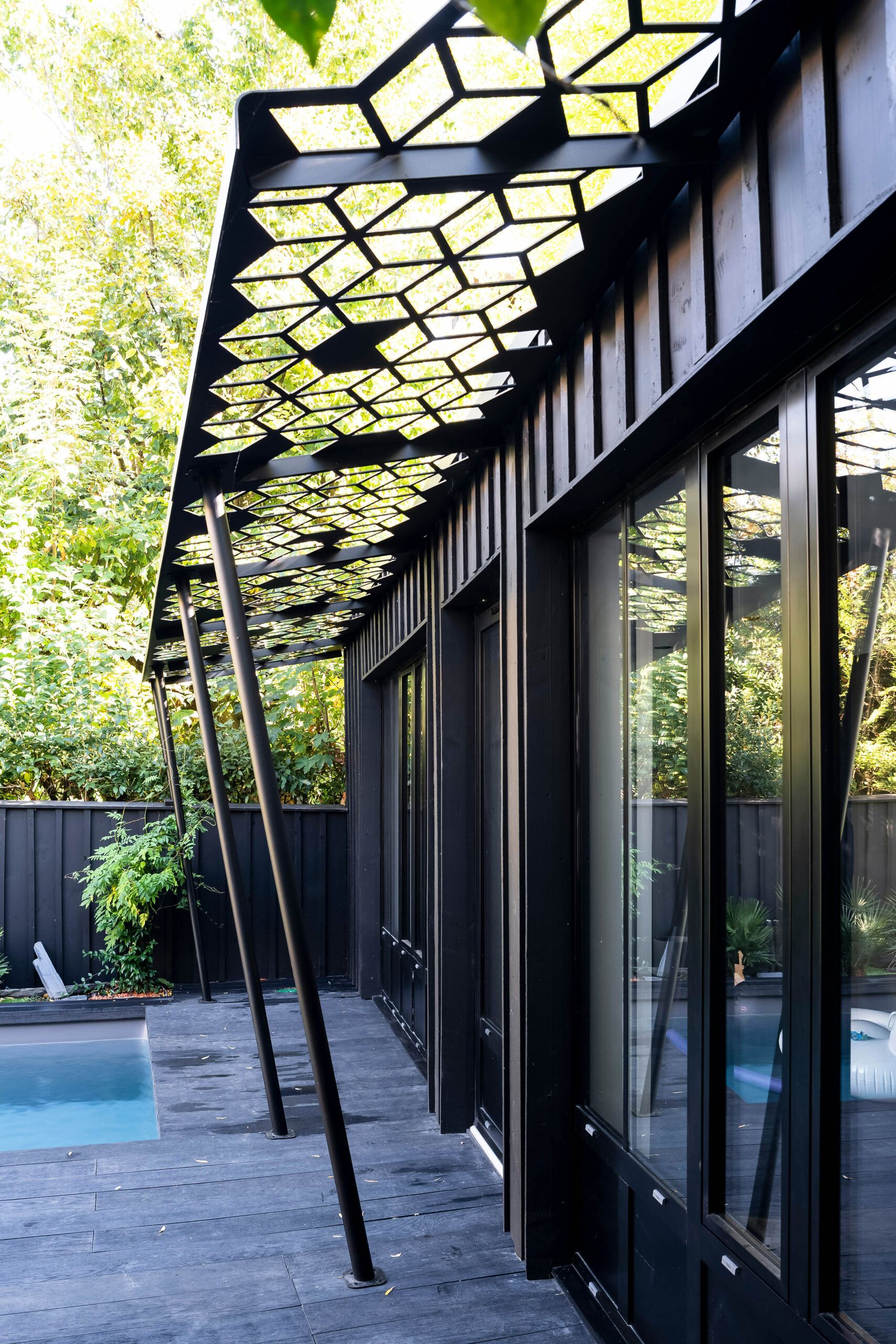
For a sleek, contemporary look, consider a steel pergola. This modern option pairs exceptionally well with concrete hardscaping and minimalist furniture. To take the futuristic vibe even further, explore pergolas with automated pivoting louvers or sliding “sunroof” mechanisms (like this Pergola X model). These high-tech options allow you to adjust between full sun, full shade, and everything in between with ease. Additionally, incorporating LED lighting into the design can elevate the ambiance, making it perfect for evening gatherings. For DIY enthusiasts with welding skills, creating a pergola out of steel pipe can be an exciting and rewarding project that showcases industrial elegance.
Try a Vinyl Pergola Structure
Contrary to outdated perceptions, today’s vinyl is far from cheap or flimsy. In fact, many professionals consider it an ideal material for outdoor structures. Modern vinyl pergolas are sturdy, maintenance-free, and resistant to warping, UV damage, and weather-related wear. A classic white vinyl pergola in a “picket fence” style can be the perfect complement to a traditional home or cottage. Vinyl pergolas also come in a variety of colors and styles to suit different architectural aesthetics. Additionally, they often come with warranties that ensure long-lasting performance, giving you peace of mind with your investment.
Add Some Fiberglass to Your Pergola
While fiberglass (also known as composite) pergolas may be on the pricier end of the spectrum, they offer unique benefits that make them worth considering. Fiberglass is lighter than wood yet stronger than steel, potentially reducing the need for deep footers. This material allows for larger spans without additional posts, creating a clean, contemporary look. Fiberglass pergolas are fully resistant to rust, rot, warping, and insect damage. They also hold paint extremely well, maintaining their appearance for years with minimal upkeep. Additionally, fiberglass pergolas can be customized to imitate the look of natural wood, combining aesthetics with the efficiency of modern materials.
Ensure Enough Shade for Your Pergola
The more shade a pergola provides, the more it can help cool your home’s interior, potentially leading to lower energy bills. To increase shade, consider adding purlins—smaller pieces placed on top of and perpendicular to the rafters. There are also numerous canopy options available. Look for retractable or sliding styles that offer complete control over sunlight exposure. Opt for UV-resistant materials that can be easily cleaned with a garden hose to make your pergola easier to take care of. Incorporating climbing plants on the pergola can add natural shade and contribute to an eco-friendly ambiance.
Go Beyond Beams With a Nontraditional Pergola
If traditional crossbeams don’t suit your style, consider alternative roofing options. A thatched roof can create a tropical ambiance, especially when paired with rattan furniture and potted palms. For homes with a Mediterranean or Asian vibe, a patterned screen reflecting those cultural influences could make for a stunning pergola topper. These unique roofing choices not only provide shade but also add character and visual interest to your outdoor space. Innovative roofing solutions such as solar-paneled tops are another interesting option, enabling you to harness solar power and enhance energy efficiency.
Add Substance to a Pergola With Stone
Stone pillars can lend a sense of stately permanence to your pergola, whether you prefer classical columns or a more rustic, natural style. If natural stone is beyond your budget, consider posts encased in covers made of realistic faux stone. For an interesting textural contrast, try mixing materials, such as wood beams atop stone bases. This combination of elements can create a visually striking and architecturally interesting pergola that becomes a true focal point in your outdoor space. Stone elements can also be integrated into the surrounding landscape, creating a seamless transition between the pergola and garden.
Deciding Between an Attached or Freestanding Pergola
When deciding between an attached or freestanding pergola, consider your available space and intended use. Wall-mounted pergolas are often better suited for smaller areas like side yards or decks. In this design, the upper framing is anchored to the wall on one side, with two footings or posts reaching the ground on the opposite side. Ensure that the mounting wall is sturdy enough to provide adequate support; otherwise, the pergola could collapse, potentially causing injury or property damage. Freestanding pergolas offer more flexibility in placement and are ideal for larger spaces or areas further from the house. They can also be used to create distinct outdoor “rooms,” providing structure and functionality.
Encourage Plant Life Around Your Pergola
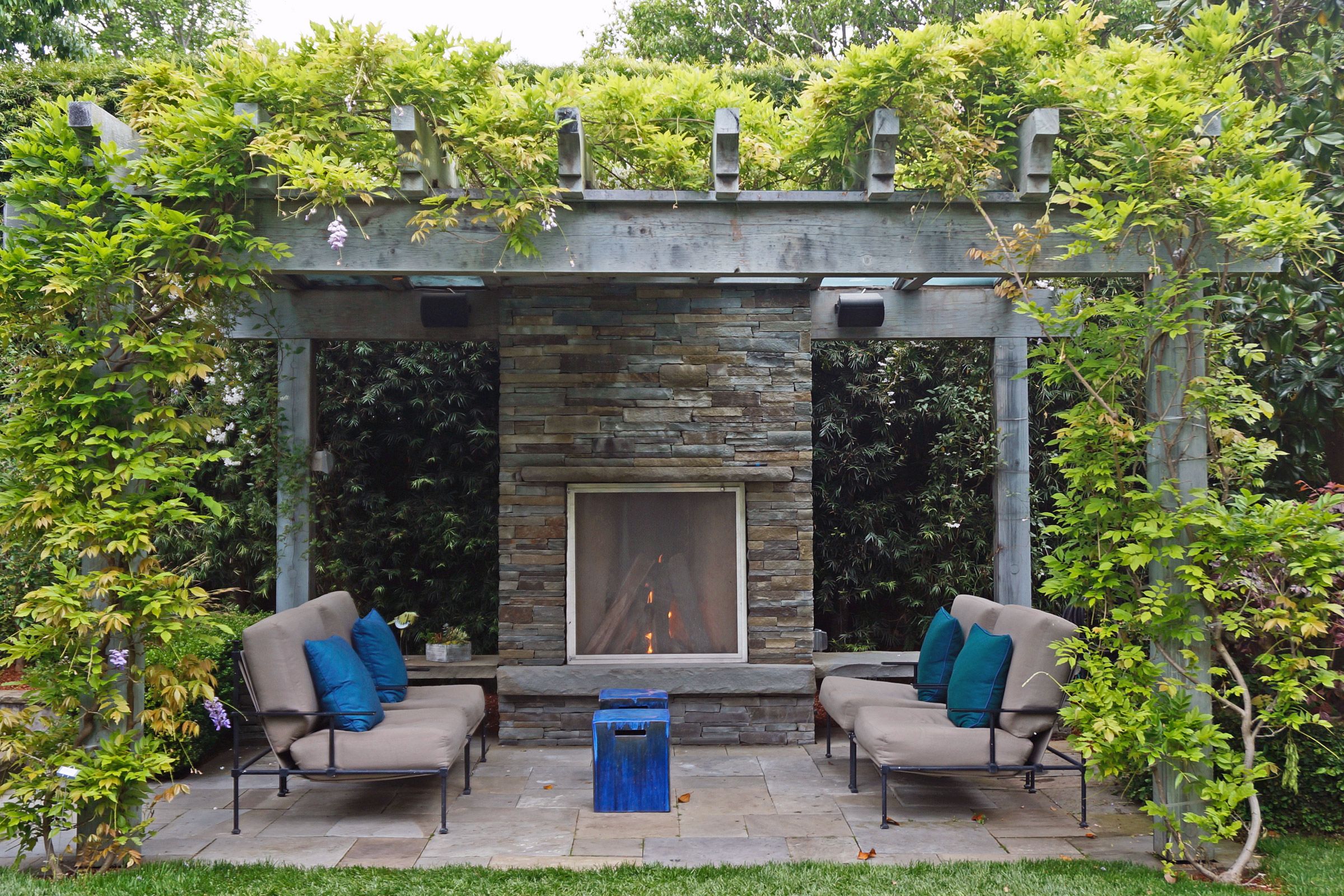
One of the most charming aspects of a pergola is its ability to support and showcase plant life. Take advantage of its arbor-like structure by incorporating climbing vines, hanging baskets, and potted shrubs. These plants can form natural walls and ceilings, further blurring the line between your home and yard while enhancing the outdoor appeal of your space. Consider fragrant climbers like jasmine or wisteria for added sensory appeal, or opt for evergreen vines for year-round greenery. Integrating flower boxes or garden beds at the base of the pergola can further enhance its integration with the surrounding landscape.
Create a Corner Pergola
A corner pergola can create an intimate nook in an open space or define an existing corner. Also known as a cabana-style pergola, this design is formed by two sides with a triangular roof. By placing seating along the sides with a table in the center, you can create the ideal spot for conversation and cocktails. This setup is perfect for small gatherings or as a cozy retreat for reading or relaxation. Corner pergolas can also be enhanced with corner shelving or planters, adding functionality and aesthetic appeal.
Build a Pergola Over a Bar
For those who enjoy outdoor entertaining, consider building a pergola over a bar area. This can range from a full-on tiki bar to a more classic and sophisticated setup. At minimum, include space for several stools on one side of the bar and shelving on the other for mixology supplies. This creates a dedicated space for preparing and enjoying drinks, making your pergola a natural gathering spot for social events. Additionally, integrating ambient lighting and sound systems can elevate the entertainment experience, making your bar pergola the highlight of any event.
Pair a Pergola with a Fire Pit
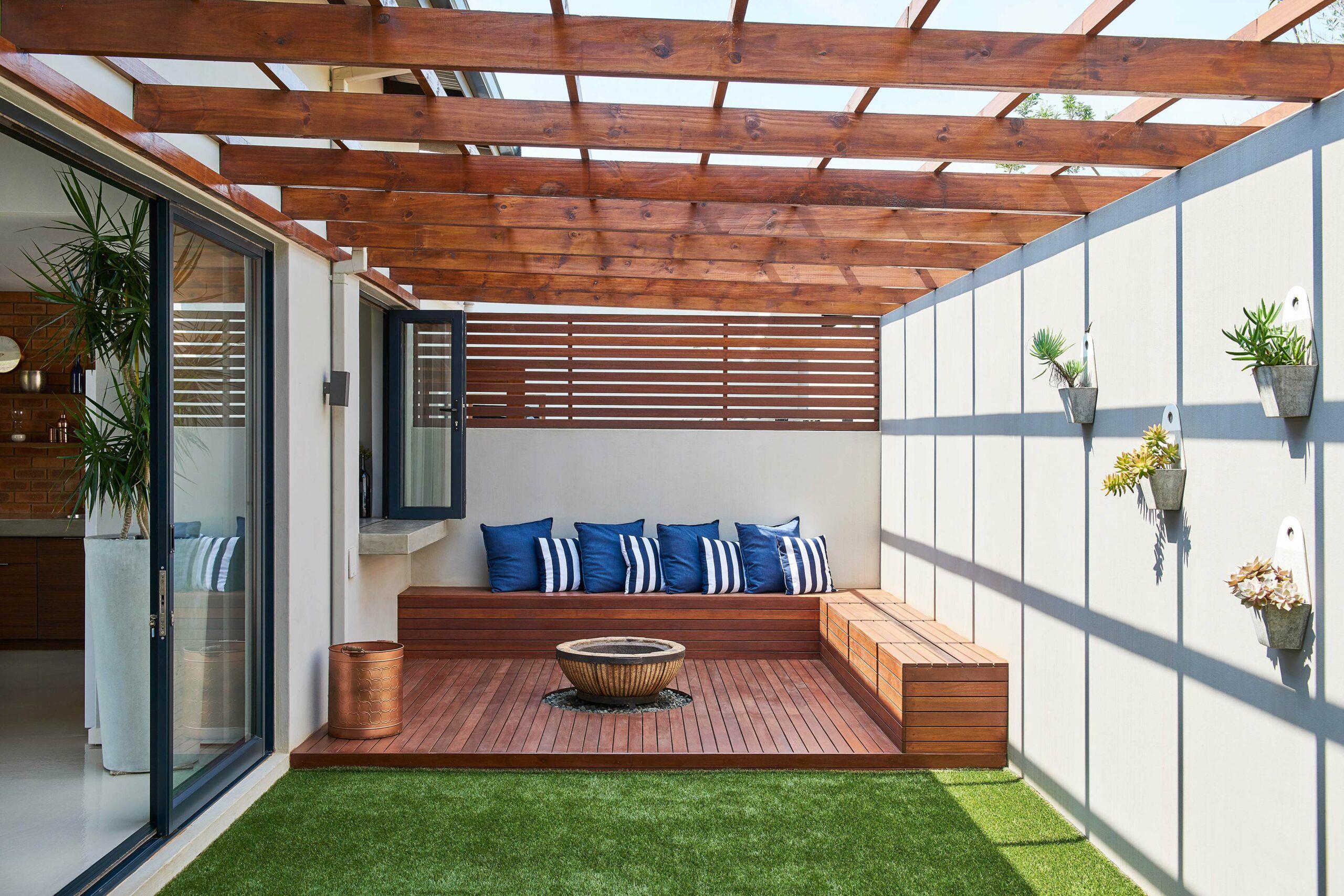
Few outdoor features are as inviting as a fire pit sheltered by a pergola. This combination creates a cozy, intimate space perfect for evening gatherings. However, safety is paramount when combining these elements. Ensure there’s adequate clearance between the flames and the overhead structure: about 94 inches for liquid propane and 120 inches for natural gas fire pits. Due to their unpredictable nature, wood-burning fire pits are not recommended for use under pergolas. Further safety measures include installing fire-resistant materials for the pergola’s base and ensuring proper ventilation to avoid smoke accumulation.
Cover Your Grill With a Pergola
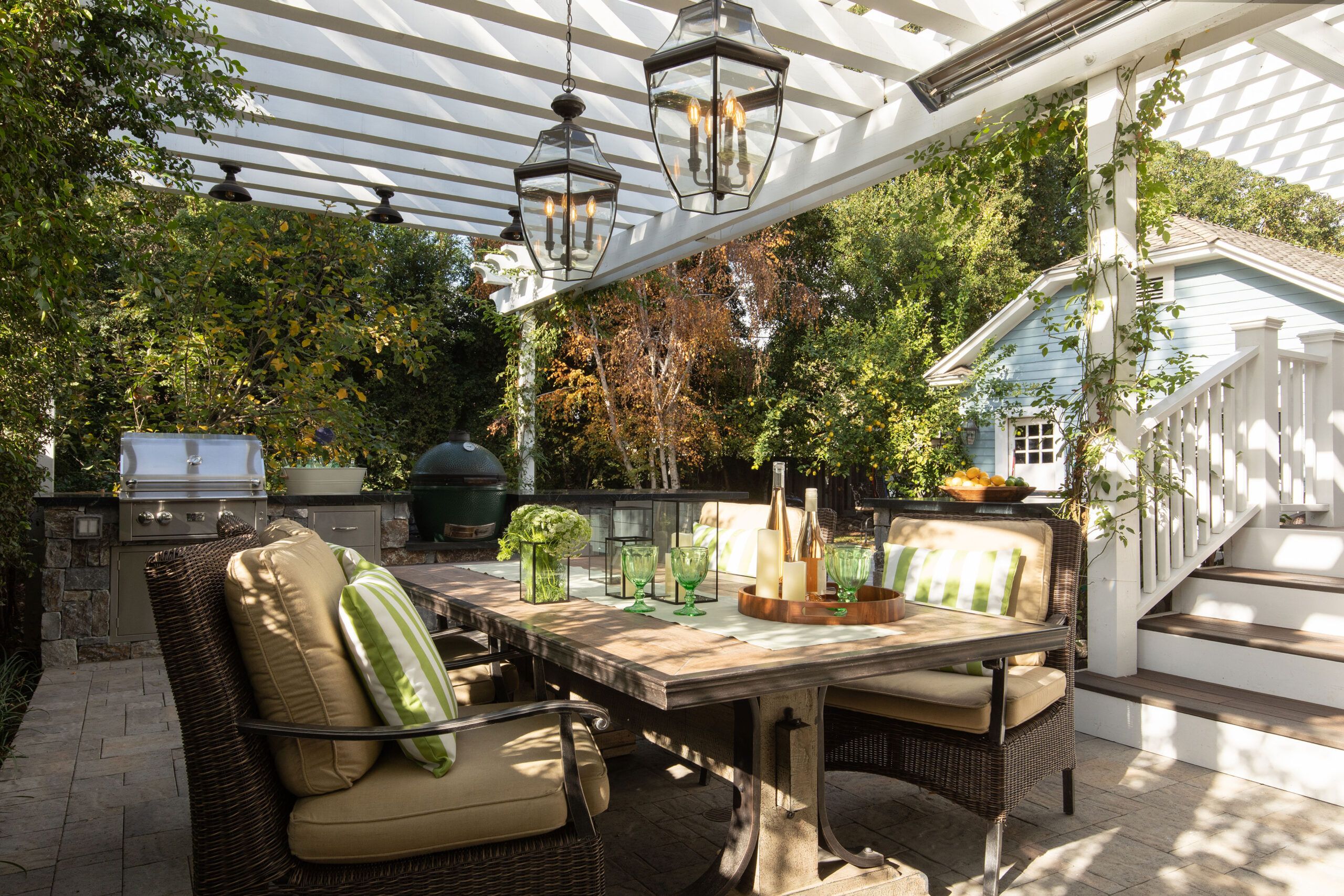
Whether you’re dreaming of a complete outdoor kitchen or simply want to define your cookout station, a pergola can be an excellent solution. A popular simple design includes a grill set in stone with countertops for food prep on either side. For a more elaborate setup, expand the framework to include a fireplace or brick oven, and perhaps add bar-height seating along one side. This creates a functional and attractive outdoor cooking and dining area that’s perfect for entertaining. Additional features such as built-in storage, refrigeration units, and even outdoor sinks can make your pergola kitchen as convenient as your indoor one.
Add a Pergola to Improve Your Pool Area
After a refreshing swim, skip the sunbathing and relax under a freestanding poolside pergola. This structure can shelter several lounge chairs for post-swim relaxation or house a table and chairs for casual meals. It provides a shaded retreat from the intense poolside sun, allowing you to enjoy your outdoor space comfortably for longer periods. Consider adding outdoor curtains or screens for additional privacy and sun protection. Poolside pergolas can also be equipped with fans or misters to keep you cool during hotter days.
Seclude a Spa in a Pergola
A pergola filtering sunlight above your hot tub can enhance your spa experience, allowing you to linger in the water longer without overexposure to direct sunlight. For added privacy, consider a version with adjustable drapes or partial walls made of slats, screens, or trellis material. This creates a secluded oasis perfect for relaxation and rejuvenation. Add some soft lighting and a sound system for a truly luxurious outdoor spa experience. Additional features such as towel racks, storage cabinets, and waterproof seating can further enhance the usability and comfort of your pergola-covered spa.
